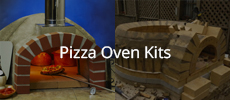Announcement
Collapse
No announcement yet.
2024 Neapolitan oven build
Collapse
X
-
daidensacha If you care to check it out, I've tried to document in my build thread as much as I can our use of retained heat. The last post is our second time doing a turkey. It was about 15 pounds.
-
I hadn‘t thought of using it to dry herbs, that’s a great idea.Originally posted by Gulf View PostI agree "lots of uses". The oven's are fun to experiment with temps on the decline. The third or fourth day (250-275F) can be great for low and slow ribs or brisket. I even made yogurt once at around 110F. I now use my oven a lot for for drying or roasting herbs with the heat left over from a food cook
Leave a comment:
-
Theres such a jump from intellectually understanding, to experiencing. I totally underestimated the power of the oven, its beyond what I could have imagined. I‘ve been making the most of the retained heat day 2 and 3 to cook bread and meat. It‘s just amazing how efficient it is. I get a more even heat in the pizza oven than I get in out kitchen oven.Originally posted by UtahBeehiver View PostYes, that is the beauty of the WFOs, pizza first night, bread the second day AM and roast second day PM. Some builders the third day or so to dry out green wood, dry herbs, make jerky etc. Gulf filters out the ash and saves the lump charcoal. So lots of uses.
Whilst my Ash hardwood is seasoned and dry, with the humidity here the wood holds some moisture. It burns but takes a little to get going. To get around this, I‘ve been loading wood for my next fire in the oven once the temp drops to 200C, and it makes a huge difference. When I light my fire, within 2 minutes it a raging blaze and the pre-heated and dried pieces of wood that I add to the fire burn instantly. It’s shortened my heating time for the oven considerably.
What surprises me is when I come to clean out the ash, there is no coals and for all the wood I burn, only 2 pans of ash come out. It’s super efficient. I‘ve been adding the ash to my blueberry bush beds.
Did my biga today for the 100% biga dough I will make tomorrow for my wife’s birthday party. I‘m budgeting on making 24 pizzas. I‘ve been baking 2-3 times a week just to get to know the oven, and learn through experience. Been baking 4-6 pizzas per bake. Finished my first 10kg bag of 00 flour making my biga today, so that’s about 60 pizzas experience. It’s been worth it, feeling ready to hit it tomorrow with a level of confidence.
Leave a comment:
-
I agree "lots of uses". The oven's are fun to experiment with temps on the decline. The third or fourth day (250-275F) can be great for low and slow ribs or brisket. I even made yogurt once at around 110F. I now use my oven a lot for for drying or roasting herbs with the heat left over from a food cook1 Photo
Leave a comment:
-
Yes, that is the beauty of the WFOs, pizza first night, bread the second day AM and roast second day PM. Some builders the third day or so to dry out green wood, dry herbs, make jerky etc. Gulf filters out the ash and saves the lump charcoal. So lots of uses.Last edited by UtahBeehiver; 12-22-2024, 07:53 AM.
Leave a comment:
-
So your using your ovens retained heat to bake too, that’s nice to hear.Originally posted by JRPizza View PostWe frequently cook chickens and on Thanksgiving we cook a turkey or two. Usually fire the oven the night before either for pizza or just to get it saturated with heat (clear dome plus an hour or so). Chickens are usually done in 45 minutes to an hour. Usually like the temp around 450F. We don't even cover them - when we pull the door plug the steam just rolls out. It's a pretty forgiving process as we have overcooked our birds on occasion and they are still moist.
I pick up my duck/ducks today, 2 x 3kg or one big one. I‘m curious how long your turkeys get on in the oven. How long did they take to cook, and at what temp do you put them in the oven? From my experience in Aus, where we always had Turkey for xmas, we always had to be careful not to dry it out.
My I did a 3 kg duck last year in my grill on the rotisserie at 190C. I had the infra red bar a little hot so it was slightly overdone, but still juicy and and really yummy.
I‘ve cooked ribs in the oven and the second lot i baked were the best I tasted in my life. Yet to do a chicken. I discovered the other day that the farm where we buy our ducks also sell freshly slaughtered chickens. I‘m not keen on the frozen supermarket ones here in Germany, they look really scrawny compared to what I used to buy in Australia.
Leave a comment:
-
We frequently cook chickens and on Thanksgiving we cook a turkey or two. Usually fire the oven the night before either for pizza or just to get it saturated with heat (clear dome plus an hour or so). Chickens are usually done in 45 minutes to an hour. Usually like the temp around 450F. We don't even cover them - when we pull the door plug the steam just rolls out. It's a pretty forgiving process as we have overcooked our birds on occasion and they are still moist.
Leave a comment:
-
david s I will try your recipe with chicken. We are getting 6 kg of duck, 1 big or 2 small, I‘m leaning towards 2 x 3kg as I think it will taste better. I will let you know how it gets on.
Last year I did the duck on the rotisserie in my grill, and it was really good. I‘m looking forward to seeing how it comes out of the Pizza oven.
Leave a comment:
-
I quite often roast chickens in my oven. but also roast other meats using the same technique. Usually one bird at a time but sometimes 2.Originally posted by daidensacha View PostRoasting duck using retained heat, or with coals
I wonder if someone with experience can share some advise. I‘m roasting our 2 Xmas ducks in the oven on 24th, and could use some tips.
On 23rd we are having a pizza party, and I had planned on closing the oven up overnight so the retained heat temp next day will be around 360C. I was planning on using the retained heat to cook the ducks, in hotel pans (530 x 325 x 90mm). I’ll cover the ducks with foil to retain moisture and protect them a bit from burning. Two pans with 2 cold ducks in a lot of mass, which will suck a lot of heat in the oven initially, so starting at 360C, I am banking on the temp dropping a fair bit, and I can measure the internal temp with a probe thermometer at hour intervals.
An alternate plan would be to leave the door ajar overnight, in which case the temp the next day is 220C. I can light a fire to get some coals in the oven, and let it burn down to cooking temp before putting ducks in and roasting with coals at the sides of the oven.
Has anyone cooked large birds or pieces of meat in the oven?
I couldn't see much point in taking the oven up to pizza temperature to roast a chicken at 200C. It takes a lot of time, firing up then waiting for the temperature to drop to roasting range, plus it goes through a lot more fuel. Also the floor gets way too hot which makes any meat juices burn in the roasting pan. (Don't use a teflon coated pan for this reason).
So I've developed this technique which works pretty well for me and my oven.All ovens are a bit different so experimentation is the key.
I fire the oven for one hour from lighting the match. This takes my oven up to around 250C, the carbon is burning off the crown at this point (300C), but the sides are still black.
With the chicken(s) sitting on a rack in the roasting pan that has some herbs and 1/2 cup of water 1/2 cup of wine akso sitting on the bottom of the tray. This takes the sting out of the floor. eliminating any buring in the pan whilst catching meat juices. The sides of the roasting pan ensure no coals or ash get in the pan.
I wait for the flame to die, push the coals back and to the sides then slide in the roasting pan and fit the door. In my oven this results in extinguishing the fire, leaving unburnt coals because of the lack of oxygen. If you want a smoky flavour place the pan just before the flame dies or throw half a handful of smoking chips onto the coals just befor placing the pan in the oven. It is very easy to overdo the smoky flavour so hold back on this.
I usually turn the bird over after 15 mins, but beware, opening the oven door releases a lot of hot air so don't do this frequently or you'll lose too much heat. At around the 3/4 point of the roast the smell is really nice and I use this as a roasting time indicator, I use a simple probe thermometer to test the internal temperature, but also sometimes use a fancy wireless probe (Meater) that talks to my phone. By the time the bird(s) are ready, around 1.5 to 2 hrs the temp is down to about 160C
Remove the herbs and the pan has exactly the right amount of liquid and caramelization from the wine, meat juice and smokiness to make the best gravy, finished on the stovetop, that you can imagine. The fluid in the pan ensures a steamy oven atmosphere so if you want crispy roast potatos do them separately in your kitchen oven. I usually accompany the roasted birds with pumpkin and onion. In my smallnove I'd usually use about the same weight in wood as the bird(s) vegetables and pan.Last edited by david s; 12-21-2024, 01:51 AM.
- Likes 1
Leave a comment:
-
Roasting duck using retained heat, or with coals
I wonder if someone with experience can share some advise. I‘m roasting our 2 Xmas ducks in the oven on 24th, and could use some tips.
On 23rd we are having a pizza party, and I had planned on closing the oven up overnight so the retained heat temp next day will be around 360C. I was planning on using the retained heat to cook the ducks, in hotel pans (530 x 325 x 90mm). I’ll cover the ducks with foil to retain moisture and protect them a bit from burning. Two pans with 2 cold ducks in a lot of mass, which will suck a lot of heat in the oven initially, so starting at 360C, I am banking on the temp dropping a fair bit, and I can measure the internal temp with a probe thermometer at hour intervals.
An alternate plan would be to leave the door ajar overnight, in which case the temp the next day is 220C. I can light a fire to get some coals in the oven, and let it burn down to cooking temp before putting ducks in and roasting with coals at the sides of the oven.
Has anyone cooked large birds or pieces of meat in the oven?
Leave a comment:
-
Giovanni Rossi You know, growing up in Aus vegemite is in my blood, and I love the saltiness of it. When I was around 40 or so, somehow I added mashed banana on my vegemite toast one day, and discovered how good they complimented each other. The salt and the sweet, on my palette anyway hits the spot.
I‘m not quite there to let people make their own pizzas yet, as I‘m developing my relationship with the oven, and hours of experience is the only thing that will give me the understanding of it. Some day soon though, it will get to that. Still early days. I am waiting on my granit top for the work benchtop, and will put a nice slice of oak on the brick wall at the back of the work bench, as a bar. Ordered some containers for my ingredients, which will enable me to organise it a bit more. Lastly, plan on building cupboards under my work bench, one side for storing my cooking trays, pots and pans, and the other side for trays of pizza dough balls.
I plan on getting a fridge for the terrace, to keep the pizza ingredients, and to have extra space to refrigerate my dough for longer proofs. For now though, with limited space, I‘m working with room temp proofs, and its going good.
I love baking, and have baked a lot of bread with sourdough and poolish, but my favorite is biga these days. Using biga in the pizza dough gives it a really nice rise, and crust.
The biga I make at 50% hydration, which confused me in the beginning because I was used to working with high hydration doughs. The biga is really dry, and scraggly, but over 24 hours it settles and comes together nicely. When I put it in my container it loose, it measures at the 4PT mark, then slowly compacts down to about half of that, then rises 24 hours to double in size again this time compacted.
Yesterday I had 2 x 280g balls left over, so i let them proof another 24 hours and today I combined them and put them in a proofing basket. Baked it in the oven with the retained heat from last nights pizza bake.
This bread from the left over pizza balls, had 24 hour biga proofing, with a further 30 hour dough proofing all at room temp before baking. Soft, moist and fluffy crumb, with really tasty crust.
Just to add, I believe, although I haven‘t yet done it, that the biga dough balls can also be kept in the fridge for up to 4-5 days. I‘ll give it a go when I have more fridge space. We have a birthday pizza party on Monday 23rd, for about 27 people, so our fridge and freezer space is pretty full right now.
24th, am cooking 2 ducks in the pizza oven for xmas dinner. Then looking forward to a breather, as I‘ve been baking 2-3 times a week just. to get hours of experience under my belt for this Xmas cooking. I feel ready now, bring it on.Last edited by daidensacha; 12-20-2024, 09:59 AM.
- Likes 2
Leave a comment:
-
I've never been a big fan of sweet on pizza, though my palate is expanding in my old age. I have enjoyed a drizzle of balsamic glaze on a savory pie now and again. My daughter is the pizzaiola during our parties while I bake and she makes a cheesy pesto pie that seems to be a fan favorite: Light tomato sauce, light shredded cheese blend (mozz, jack, prov), light shredded cheddar, dollops of pesto, parmigiano reggiano, red pepper flakes and EVOO.Originally posted by daidensacha View PostI‘ve got to experiment with the pesto, and see how to best incorporate the mango...
I will make just about any combo a guest wants, but one local favorite that will never see the inside of my oven is a buffalo chicken pie!
Enjoying your info on using a biga for pizza. I use various pre-ferments for most of my breads, but have never done so for pizza. That would certainly save fridge space. I typically do a bulk room temp fermentation then form my balls and do a 2-3 day cold ferment. That way I just pull the balls out pre-bake for a period of time that varies by the temp on party day. This process allows pulling the dough boxes out one at a time and simplifies the prep process day of.
Leave a comment:
-
Biga Pizza Dough
As I mentioned previously, I made up a spreadsheet to allow me to refine my biga dough easily. Being winter, I‘m currently going with 100% biga, proofing for 24 hours at room temp as I have limited space in my fridge. I then add the water and salt to bring it to 65% hydration, which I have found bakes better in my oven than dough with 70% hydration.
Today I finally found the exact amount of active dry yeast that works for my schedule so it is perfectly risen at the time I want to bake. Initially when I reduced the hydration to 65%, my dough was not quite right and required a little more work to stretch out the dough when making my pizzas. Waiting for the balls to be ready makes a world of difference, as the dough becomes softer and more pliable. Much easier to shape, and still strong enough that they don’t break. The challenge has been to do this at room temperature 20C, without refrigerating, and having it ready at the time I want to bake. As we come out of winter and into warmer weather, i‘ll start to reduce the percentage of biga to slow down the rising process, again so it can be at room temp.
I‘m making my balls 280g, and in the calculation for the dough I add 10g per ball to ensure I have enough to make my 280g balls. Somehow in the process of making the dough, possibly evaporation, some weight is lost.
What I like with my spreadsheet is that I can enter the amount of pizzas I want, and it automatically gives me the recipe calculated from the bakers percentages. I can easily change the percentage of biga in the recipe, also the percentage of yeast, and hydration of the biga and or final dough. I also added a schedule calculator, which outlines my schedule based on the time I enter that I want to bake, and the specific processing times making the dough.
Leave a comment:
-
Heating oven over consecutive days to cook pizza - Day 3
Day three, again left the door ajar overnight and only opened it to clean it out at 11.30 this morning, when it was down to 220C in the oven. After cleaning, prepped the fire starting wood tower and placed it in the middle of the oven, and placed wood around the tower to dry out fully. Preheating the wood super charges the fire starting process, which is really cool. With the pre-heated and dried wood the again today it only took 45 minutes to get the oven up to cooking temp. Starting with the oven already hot from retained heat make a world of difference, and more than halves the heating time.
So today, I wanted to pre-cook my salsiccia sausage, and slice it to use then on my pizza, as opposed to breaking it up and putting it raw on the pizza to cook in the oven. I put the sausage in a cast iron frypan, and the sausages cooked beautifully in the opening of the oven in the frypan. When they were almost cooked, I added cherry tomatoes and cooked them until they were soft.
The salsiccia was salty with a strong flavor of anise, really good. I put slices of it on the pizza with cooked cherry tomatoes, mozzarella, parmigiano regiano, buffalo mozzarella. I found the salsiccia on this pizza had much more intense flavor from being fried beforehand.
Salsiccia
Crudo - mozzarella, parmigiano regiano, buffalo mozzarella, prosciutto (here exchanged with jamon serrano), sea salt, pepper, extra virgin olive oil. Topped with fresh rocket.
Using my iron dogs for every bake now, after using them last time. Gives me secure hooks to hold the wood when adding to the coals to maintain the heat and light in the oven.
rsandler Thank you for sharing your input. I‘ve long enjoyed the contrast between salty and sweet, and find they really go well together. After working in a pizza bar for 2 years, the only pizza I ever ate for since then was pepperoni with pineapple, sometimes with pickled jalapeños. Until one time this last year when ordering pizza in a local italian restaurant, they told me they didn‘t use pineapple. The waiter suggested I try roasted paprika with the hot salami and it was really good. Added the sweetness I wanted, and I prefer it over pineapple now when I have it.
I‘ve got to experiment with the pesto, and see how to best incorporate the mango, but I‘m thinking along the lines of pureeing the pesto with some ripe mango to get a sauce more easily to spread over the base. Here in Germany there are some really good smoked and salted types of bacon. Very fine stuff. I think it would go well with the sweet, and some buffalo mozzarella. I will try it this week if I find a mango I‘m happy with.
Lastly, I got tired of not having proper plates for cutting and serving the pizzas. So bought a piece of 1600x600x9mm birch plywood, and made some pizza platters with handles. The main bases are 350mm diameter, and I‘m making 300mm pizzas so there is space to spare.
Last edited by daidensacha; 12-19-2024, 02:39 PM.
- Likes 1
Leave a comment:
-
We're big on experimenting with pizza toppings, so love to see it . A few thoughts for free disposal:
. A few thoughts for free disposal:- Pesto goes really well with any salty, cured meat. Many restaurants just do chicken, or at most Italian sausage, but pepperoni, bacon, capicola, even Chinese sausage all go really well.
- The "Hawaiian pizza" (essentially ham and pineapple, an American thing) gives fruit on pizza a bad name. There are some combos that are killer, and connect to certain sweet-savory combinations found elsewhere in Italian cuisine (even if you'll never see Italians do this on pizza): Sausage with halved grapes; bacon with blueberries; prosciutto with sliced strawberries (or sliced apple/pear to be more traditional). Works with either red sauce or olive oil as the base. Apple butter as a base works well for prosciutto also.
- Speaking of Hawaiian, if you *grill* the pineapple (in the oven while its heating, for instance), that's a whole different ballgame. Barbecue sauce, grilled pineapple and bacon is to die for.
- We've done a lot of putting leftovers on pizza. Some become more than the sum of the parts, others taste like the leftovers shaped like a pizza. Meats with a pan sauce tend to work well (chicken piccata is a hands down favorite). Curries FWIW, have tended to be in the "leftovers shaped like a pizza" category. YMMV.
Happy pizza-making! Yours are looking great!
Leave a comment:





Leave a comment: